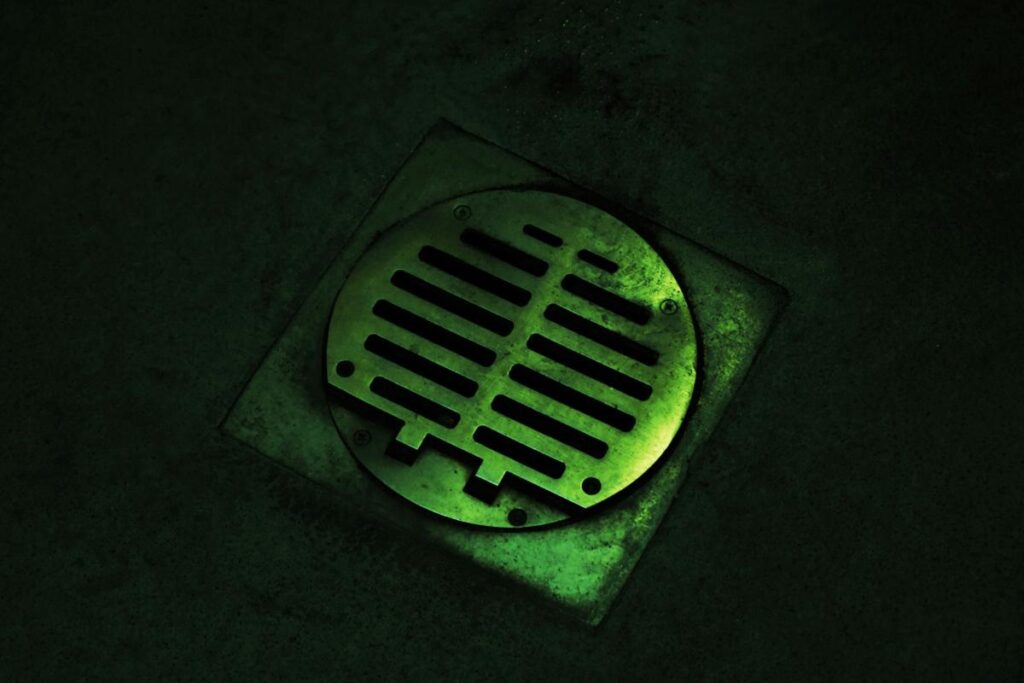If you’ve discovered standing water or a foul smell near your basement floor drain, you may be facing a basement drain clogged with dirt, grease, or even roots. While a little water might seem harmless, what starts as a slow drain can quickly turn into a basement drain backup, sewage backup, or even structural damage to your home.
Many older homes are especially prone to clogged basement floor drains because of outdated drainage systems and aging drainage pipes. Fortunately, understanding the possible causes, knowing the first steps to take, and following a few simple steps for maintenance can prevent costly repairs later.
How a Basement Drain System Works
Your basement drain system is designed to move excess water away from your home. It’s typically located at the lowest point of your basement or garage floor drain, where gravity naturally pulls water flow toward it.
This drain connects to your home’s main line, which may also handle wastewater from your kitchen sink, bathrooms, or laundry area. When everything is clear, water pressure helps flush away small debris and keep the drainage pipes clean.
But when a sewage clog or soap scum buildup forms, water can no longer move freely. The result? Slow drainage, sewer gases, or even a backed-up basement floor drain that sends gallons of water flooding back into your living space.
Common Reasons for Basement Drain Clogs
There are several common reasons your basement drain clogs — some easy to fix, others requiring professional plumbing services.
- Dirt, Lint, and Small Particles
Over time, small particles like dirt and laundry lint collect inside the pipe. Without regular maintenance, they harden and restrict water flow. - Soap Scum and Grease
If your washer or kitchen sink empties into the basement line, soap scum and grease create sticky buildup that traps debris. Even a few paper towels flushed accidentally can worsen the blockage. - Tree Roots in Drainage Pipes
In older homes, underground drainage systems often have tiny cracks. Tree roots find these openings, growing into the main line and creating a stubborn clog that no drain auger can clear without cutting. - Collapsed or Leaking Pipes
A drain pipe leaking in the basement might signal severe damage to your plumbing. Broken joints or collapsed sections allow soil to enter, creating slow drainage and foul smells. - Sewage Systems Backups
During heavy rainfall, municipal sewage systems can overflow, forcing extra water and waste back into your basement floor drain. Installing a backwater valve is often the best way to prevent this. - Fall Drain Clogs
Leaves and mud tracked in from outside can clog the garage floor drain or basement floor drain in autumn. Seasonal cleanup is essential to avoid future clogs.
Signs Your Basement Drain Pipe Is in Trouble
Recognizing early warning signs can help you take quick action before severe damage sets in. Watch for:
- Slow drainage or standing water after cleaning.
- Gurgling noises when using other fixtures.
- A persistent foul smell near the drain.
- Damp spots, mold, or mildew at the lowest point of the basement.
- Recurring water backups during storms or laundry cycles.
- Evidence of a drain pipe leaking in the basement.
If these problems appear, it’s a good idea to start troubleshooting immediately or contact a professional plumber.
DIY Fixes Using Simple Tools and Basic Steps
You can handle many small clogs yourself using simple tools and basic plumbing knowledge. Follow these simple steps:
- Remove the Drain Cover
Use rubber gloves to take off the metal grate. Shine a flashlight to check for visible debris. - Check the Clean-Out Plug
Most basement floor drains include a clean-out plug. If you see buildup here, remove it gently using a screwdriver or small wire brush. - Use a Sturdy Plunger
Create a tight seal over the drain and plunge several times. This can help loosen small clogs caused by lint or soap scum. - Try an Electric Snake or Drain Auger
For deeper clogs, insert an electric snake or drain auger into the pipe. Feed the auger cable slowly until you feel resistance, then rotate to break apart debris. - Wet Dry Vacuum
A wet dry vacuum set to liquid mode can suck out little water and debris near the surface. This is especially useful for backed-up basement floor drains. - Use a Natural Solution
Pour a mix of boiling water, vinegar, and baking soda into the drain. This natural solution dissolves grease and soap scum without harsh chemicals. - Flush with a Garden Hose
Once the clog breaks free, run a garden hose down the drain for several minutes to confirm good water flow.
If water continues to back up, or if you smell sewer gases, the issue may be deeper in the main line and require professional services.
When to Call for Professional Solutions
If the problem persists after you’ve tried basic tools, it’s time for professional solutions. A professional plumber or drain cleaning service has years of experience dealing with basement drain clogs and sewage systems.
They can use video inspection to pinpoint blockages, pressure-test lines for leaks, and clear the entire drainage system with hydro-jetting. These plumbing services can also verify that your french drain or sump pump is working properly.
Professionals may also address connected systems like garage floor drains, basement drain systems, or exterior drainage pipes to ensure all water has a clear path away from the home.
Health Risks and Safety Concerns
Ignoring a clogged drain pipe in the basement isn’t just inconvenient — it can be dangerous. Stagnant water breeds bacteria, mold, and insects. Sewage backup introduces pathogens into the air, posing health risks to your family and pets.
Sewer gases leaking through a clogged basement floor drain can cause headaches, nausea, or respiratory issues. Always wear rubber gloves and eye protection when working with drains, and never mix chemical cleaners.
If you notice sewage systems backing up repeatedly, quick action is crucial to avoid contamination and costly repairs.
Preventing Future Basement Drain Problems
Keeping your drainage system healthy requires regular maintenance and good habits. Here’s how to stay ahead of future clogs:
- Clean Monthly
Pour boiling water into the drain once a month to dissolve grease. A few minutes of regular maintenance can prevent small clogs from forming. - Avoid Flushing Debris
Never flush paper towels, wipes, or grease. These can cause a sewage clog deep in the main line. - Inspect After Heavy Rainfall
After storms, check for basement floor drain backup or standing water. Heavy rainfall often overwhelms sewage systems, forcing extra water into your basement. - Maintain a Tight Seal
Ensure the clean-out plug and drain cover fit securely. This prevents sewer gases from escaping and odors from spreading. - Install a French Drain or Backwater Valve
If your basement frequently floods, adding a french drain or backwater valve is the best way to divert excess water and protect your foundation. - Hire Drain Cleaning Services Annually
Professional drain cleaning services can snake your lines and remove early buildup before it becomes a big issue. - Use Applicable Laws for Major Repairs
Always follow applicable laws or plumbing codes when replacing drainage pipes or installing new systems. Improper installation can cause severe damage and void insurance coverage.
Types of Drains Found in Basements
Not every basement has the same type of drain. Knowing your setup helps you apply the right long-term solutions:
- Floor Drain – Common in most basements, located at the lowest point to capture excess water.
- Sump Pump Drain – Connects to a pump that moves water away automatically.
- French Drain System – Installed along basement perimeters to relieve water pressure from outside walls.
- Garage Floor Drain – Handles runoff from vehicles or snow melt.
Each of these drains can experience similar blockages, but their drainage systems may require different cleaning techniques.
Why Quick Action Matters
Many homeowners wait until the backed-up basement floor drain floods before taking action. But even a little water can hide deeper problems in the main line. Acting fast prevents severe damage and protects indoor air quality.
Taking the first step—checking for debris, ensuring good water flow, and calling a professional plumber when necessary—can save you from costly repairs and weeks of cleanup.
Final Thoughts: Protecting Your Basement from Drain Problems
A clogged basement floor drain isn’t something to ignore. Whether caused by soap scum, tree roots, or a sewage backup, even small clogs can escalate quickly.
With the right simple tools, some basic steps, and occasional professional services, you can keep your basement drain system running smoothly for years to come. If you ever face recurring basement drain clogs, slow drainage, or a drain pipe leaking in the basement, don’t wait. Take quick action to protect your home and your family’s health.
And remember — regular maintenance and smart prevention are always the best way to keep your basement dry, safe, and ready for whatever the next storm brings.



